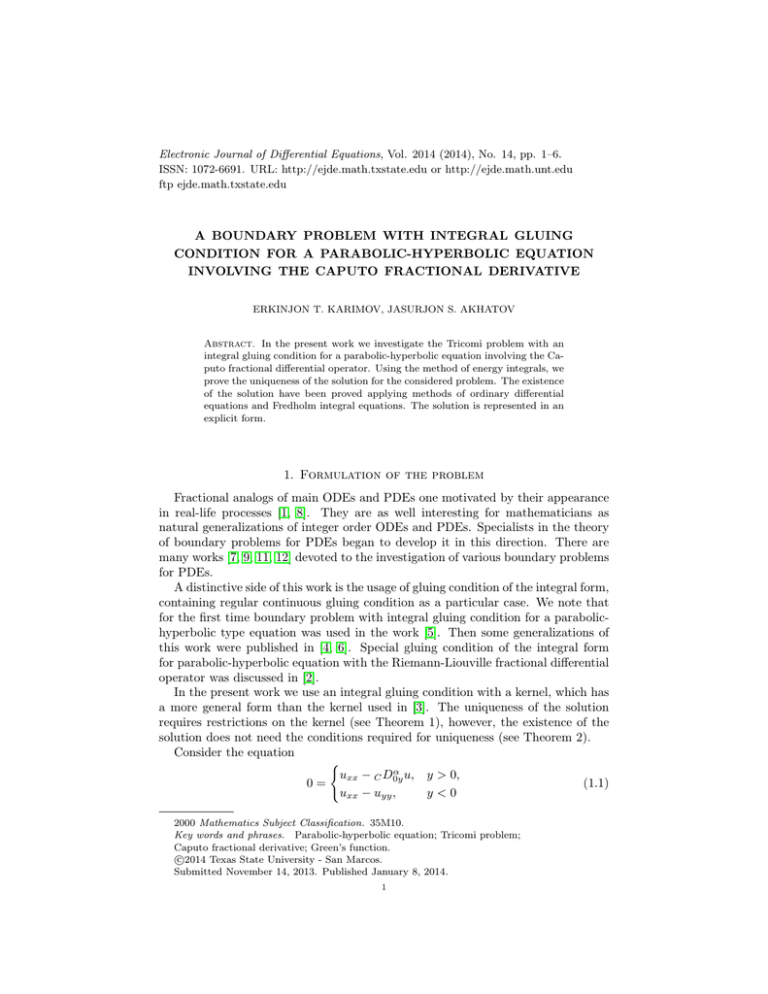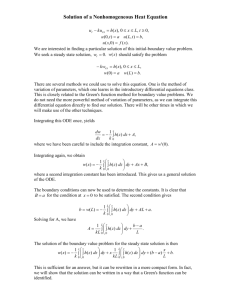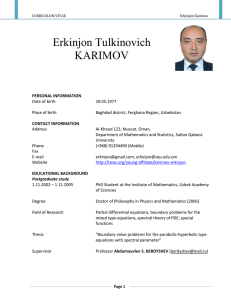Electronic Journal of Differential Equations, Vol. 2014 (2014), No. 14,... ISSN: 1072-6691. URL: or
advertisement

Electronic Journal of Differential Equations, Vol. 2014 (2014), No. 14, pp. 1–6.
ISSN: 1072-6691. URL: http://ejde.math.txstate.edu or http://ejde.math.unt.edu
ftp ejde.math.txstate.edu
A BOUNDARY PROBLEM WITH INTEGRAL GLUING
CONDITION FOR A PARABOLIC-HYPERBOLIC EQUATION
INVOLVING THE CAPUTO FRACTIONAL DERIVATIVE
ERKINJON T. KARIMOV, JASURJON S. AKHATOV
Abstract. In the present work we investigate the Tricomi problem with an
integral gluing condition for a parabolic-hyperbolic equation involving the Caputo fractional differential operator. Using the method of energy integrals, we
prove the uniqueness of the solution for the considered problem. The existence
of the solution have been proved applying methods of ordinary differential
equations and Fredholm integral equations. The solution is represented in an
explicit form.
1. Formulation of the problem
Fractional analogs of main ODEs and PDEs one motivated by their appearance
in real-life processes [1, 8]. They are as well interesting for mathematicians as
natural generalizations of integer order ODEs and PDEs. Specialists in the theory
of boundary problems for PDEs began to develop it in this direction. There are
many works [7, 9, 11, 12] devoted to the investigation of various boundary problems
for PDEs.
A distinctive side of this work is the usage of gluing condition of the integral form,
containing regular continuous gluing condition as a particular case. We note that
for the first time boundary problem with integral gluing condition for a parabolichyperbolic type equation was used in the work [5]. Then some generalizations of
this work were published in [4, 6]. Special gluing condition of the integral form
for parabolic-hyperbolic equation with the Riemann-Liouville fractional differential
operator was discussed in [2].
In the present work we use an integral gluing condition with a kernel, which has
a more general form than the kernel used in [3]. The uniqueness of the solution
requires restrictions on the kernel (see Theorem 1), however, the existence of the
solution does not need the conditions required for uniqueness (see Theorem 2).
Consider the equation
(
α
uxx − C D0y
u, y > 0,
0=
(1.1)
uxx − uyy ,
y<0
2000 Mathematics Subject Classification. 35M10.
Key words and phrases. Parabolic-hyperbolic equation; Tricomi problem;
Caputo fractional derivative; Green’s function.
c
2014
Texas State University - San Marcos.
Submitted November 14, 2013. Published January 8, 2014.
1
2
E. T. KARIMOV, J. S. AKHATOV
EJDE-2014/14
in the domain Ω = Ω+ ∪ Ω− ∪ AB, where 0 < α < 1, AB = {(x, y) : 0 < x < 1, y =
0}, Ω+ = {(x, y) : 0 < x < 1, 0 < y < 1}, Ω− = {(x, y) : −y < x < y + 1, −1/2 <
y < 0},
Z y
1
−α
α
(y − t) f 0 (t)dt
C D0y f =
Γ(1 − α) 0
is the Caputo fractional differential operator of order α (0 < α < 1), Γ(·) is the
Euler’s gamma-function [10].
Problem. Find a solution of the equation (1.1) belonging to
W = {u(x, y) : u ∈ C(Ω) ∩ C 2 (Ω− ), uxx ∈ C(Ω+ ),
α
C D0y u
∈ C(Ω+ )}
satisfying the boundary conditions
u(0, y) = ϕ1 (y),
0 ≤ y ≤ 1,
(1.2)
u(1, y) = ϕ2 (y),
0 ≤ y ≤ 1,
(1.3)
0 ≤ x ≤ 1/2,
(1.4)
u(x, −x) = ψ(x),
and the gluing condition
lim y 1−α uy (x, y) = γ1 uy (x, −0) + γ2
x
Z
y→+0
uy (t, −0)Q(x, t)dt,
0 < x < 1. (1.5)
0
Here ϕ1 , ϕ2 , ψ, Q(·, ·) are given functions, such that ϕ1 (0) = ψ(0), γ1 , γ2 are constants γ12 + γ22 6= 0.
2. Uniqueness of the solution
Let us set
u(x, +0) = τ1 (x), 0 ≤ x ≤ 1, u(x, −0) = τ2 (x), 0 ≤ x ≤ 1,
uy (x, −0) = ν2 (x), 0 < x < 1, lim y 1−α uy (x, y) = ν1 (x),
y→+0
ux (x, +0) = τ 0 1 (x), 0 < x < 1,
0 < x < 1,
ux (x, −0) = τ 0 2 (x), 0 < x < 1.
It is known that the solution of the Cauchy problem for (1.1) in Ω− can be represented as
Z x+y
i
1h
u(x, y) = τ1 (x + y) + τ2 (x − y) −
ν2 (t)dt .
(2.1)
2
x−y
Using condition (1.4) in (2.1), we find
τ20 (x) − 2ψ 0 (x/2) = ν2 (x),
0 < x < 1.
(2.2)
From (1.1) as y → +0 we obtain [13]
τ100 (x) − Γ(α)ν1 (x) = 0.
(2.3)
Below we prove the uniqueness of the solution of the formulated problem. For
this aim, first we suppose that the problem has two solutions, then denoting the
difference of these solutions by u we will get an appropriate homogeneous problem.
If we prove that this homogeneous problem has only the trivial solution, then we
can state that the original problem has a unique solution.
We multiply equation (2.3) by τ1 (x) and integrate from 0 to 1:
Z 1
Z 1
00
τ1 (x)τ1 (x)dx − Γ(α)
τ1 (x)ν1 (x)dx = 0.
(2.4)
0
0
EJDE-2014/14
A BOUNDARY PROBLEM
We investigate the integral I =
(1.5), we have
R1
0
3
τ1 (x)ν1 (x)dx. Considering the gluing condition
Z
x
ν1 (x) = γ1 ν2 (x) + γ2
ν2 (t)Q(x, t)dt,
0 < x < 1.
(2.5)
0
In the homogeneous case; i.e., ψ(x) = 0, from (2.2) we obtain ν2 (x) = τ20 (x), hence
(2.5) will be written as
Z x
ν1 (x) = γ1 τ20 (x) + γ2
τ20 (t)Q(x, t)dt, 0 < x < 1.
(2.6)
0
We substitute this expression into the integral I and consider τ1 (0) = 0, τ1 (1) = 0
(which are deduced from conditions (1.2), (1.3) in the homogeneous case), we have
Z 1
I=
τ1 (x)ν1 (x)dx
0
(2.7)
Z 1
Z 1
Z x
∂
2
= γ2
τ1 (x)Q(x, x)dx − γ2
τ1 (x)dx
τ1 (t) Q(x, t)dt.
∂t
0
0
0
Let
∂
∂t Q(x, t)
= −Q1 (x)Q1 (t). Then
Z 1
γ2 Φ2 (1)
I = γ2
,
τ12 (x)Q(x, x)dx +
2
0
(2.8)
where
Z
Φ(x) =
x
Z
τ1 (t)Q1 (t)dt,
t
Q(x, t) = Q(x, 0) −
0
Q1 (x)Q1 (z)dz.
0
From (2.4) and (2.8), we obtain
Z 1
hZ
2
τ 0 1 (x)dx + Γ(α)γ2
1
Φ2 (1) i
= 0.
(2.9)
2
0
0
Since Γ(α) > 0 for 0 < α < 1, then if γ2 ≥ 0, Q(x, x) > 0 from (2.9) we easily get
τ1 (x) = 0 for any x ∈ [0, 1].
Based on the solution of the first boundary problem for (1.1) in the domain Ω+
we obtain u(x, y) ≡ 0 in Ω+ . Since u(x, y) ∈ C(Ω), we obtain that u(x, y) ≡ 0 in
Ω. Hence, we proved the following result.
τ12 (x)Q(x, x)dx +
∂
Theorem 2.1. Let γ2 ≥ 0, ∂t
Q(x, t) = −Q1 (x)Q1 (t) and Q(x, x) > 0. If there
exists a solution to problem, then it is unique.
An example of a function satisfying the conditions of theorem is
Q(x, t) = e−x (1 + e−t ).
3. Existence of the solution
From (2.2), (2.3) and (2.5), we have
τ 00 1 (x) − Aτ1 (x) = F1 (x),
(3.1)
where A = Γ(α)γ1 ,
Z x
Z x
h
i
x
t
F1 (x) = γ2 Γ(α)
τ 0 1 (t)Q(x, t)dt − Γ(α) γ1 ψ( ) + γ2
ψ 0 ( )Q(x, t)dt . (3.2)
2
2
0
0
The solution of the equation (3.1) together with the conditions
τ1 (0) = ψ(0),
τ1 (1) = ϕ2 (0)
(3.3)
4
E. T. KARIMOV, J. S. AKHATOV
EJDE-2014/14
has the form
1
τ1 (x) =
[ϕ2 (0)(1 − eAx ) + ψ(0)(eAx − eA )] +
1 − eA
Z
1
G0 (x, ξ)F1 (ξ)dξ,
(3.4)
0
where
1
G0 (x, ξ) =
A[eAx − eA(x−1) ]
(
(1 − eAξ )(1 − eA(x−1) ), 0 ≤ ξ ≤ x,
(1 − eA(ξ−1) )(1 − eAx ), x ≤ ξ ≤ 1
(3.5)
is the Green’s function of the problem (3.1), (3.3). Considering (3.2) and integrating
by parts, we obtain
Z 1
τ1 (ξ)K(x, ξ)dξ = F2 (x),
(3.6)
τ1 (x) −
0
where
Z
h
K(x, ξ) = γ2 Γ(α) G0 (x, ξ)Q(ξ, ξ) +
i
∂
Q(t, ξ)dt ,
∂ξ
(3.7)
1 ϕ2 (0)(1 − eAx ) + ψ(0)(eAx − eA )
A
1−e
Z 1
Z ξ
i
h
ξ
t
+ γ2
Q(ξ, t)dt dξ.
− Γ(α)
G0 (x, ξ) γ1 ψ
ψ0
2
2
0
0
(3.8)
ξ
F2 (x) =
1
G0 (ξ, t)
Since the kernel K(x, ξ) is continuous and F2 (x) is continuously differentiable, the
solution of integral equation (3.6) can be written via the resolvent-kernel:
Z 1
τ1 (x) = F2 (x) −
F2 (ξ)R(x, ξ)dξ,
(3.9)
0
where R(x, ξ) is the resolvent-kernel of K(x, ξ).
The unknown functions ν1 (x) and ν2 (x) will be expressed as
Z 1
i
∂2
1 h 00
F2 (x) −
F2 (ξ) 2 R(x, ξ)dξ ,
ν1 (x) =
Γ(α)
∂x
0
Z 1
x
∂
ν2 (x) = F20 (x) −
F2 (ξ) R(x, ξ)dξ − ψ 0 ( ).
∂x
2
0
The solution of the problem in the domain Ω+ can be written as
Z y
Z y
u(x, y) =
Gξ (x, y, 0, η)ϕ1 (η)dη −
Gξ (x, y, 1, η)ϕ2 (η)dη
0
0
Z
1
(3.10)
G(x − ξ, y)τ1 (ξ)dξ,
+
0
where
Z y
1
G(x − ξ, y) =
η −α G(x, y, ξ, η)dη,
Γ(1 − α) 0
∞
(y − η)β−1 X 1,β
|x − ξ + 2n| |x + ξ + 2n| G(x, y, ξ, η) =
e1,β −
− e1,β
1,β −
β
2
(y − η)
(y − η)β
n=−∞
is the Green’s function of the first boundary problem for (1.1) in the domain Ω+
with the Riemann-Liouville fractional differential operator instead of the Caputo
EJDE-2014/14
A BOUNDARY PROBLEM
5
ones [13], β = α/2,
1,β
e1,β
(z) =
∞
X
zn
n! Γ(β − βn)
n=0
is the Wright type function [13].
The solution of the problem in the domain Ω− will be found by formula (2.1).
Hence, we proved the following result.
Theorem 3.1. If ϕi (y), ψ(x) ∈ C[0, 1] ∩ C 1 (0, 1), Q(x, t) ∈ C 1 ([0, 1] × [0, 1]), then
there exists a solution of the problem and it can be represented in the domain Ω+
by formula (3.10) and in the domain Ω− by the formula (2.1).
Acknowledgements. Authors are grateful to Professor M. Kirane for his useful
suggestions, which made the paper more readable.
References
[1] T. J. Anastasio; The fractional order dynamics of brainstem vestibulo-oculomotor neurons.
Biological Cybernetics, 72 (1994), pp. 69-79.
[2] A. S. Berdyshev, A. Cabada, E. T. Karimov; On a non-local boundary problem for a parabolichyperbolic equation involving a Riemann-Liouville fractional differential operator. Nonlinear
Analysis, 75 (2012), pp. 3268-3273.
[3] A. S. Berdyshev, E. T. Karimov, N. Akhtaeva; Boundary value problems with integral gluing conditions for fractional-order mixed-type equation. International Journal of differential
Equations, (2011), Article ID 268465.
[4] B. E. Eshmatov, E. T. Karimov; Boundary value problems with continuous and special gluing
conditions for parabolic-hyperbolic type equations. Central European Journal of Mathematics,
5(4) (2007), pp. 741-750.
[5] N. Yu. Kapustin. E. I. Moiseev; On spectral problems with a spectral parameter in the boundary condition. Differential Equations, 33(1) (1997), pp. 116-120.
[6] E. T. Karimov; Non-local problems with special gluing condition for the parabolic-hyperbolic
type equation with complex spectral parameter. PanAmerican Mathematical Journal, 17
(2007), pp. 11-20.
[7] A. A. Kilbas, O. A. Repin; An analog of the Tricomi problem for a mixed type equation with
a partial fractional derivative. Fractional Calculus and Applied Analysis, 13(1) (2010), pp.
69-84.
[8] C. G. Koh, J. M. Kelly; Application of fractional derivatives to seismic analysis of baseisolated models. Earthquake Engineering and Structural Dynamics, 19 (1990), pp. 229-241.
[9] Y. Luchko; Initial-boundary-value problems for the generalized multi-term time-fractional
diffusion equation. Journal of Mathematical Analysis and Applications, 374 (2011), pp. 538548.
[10] I. Podlubny; Fractional Differential Equations, Academic Press, San Diego, 1999.
[11] Y. Povstenko; Neumann boundary-value problems for a time-fractional diffusion wave equation in a half-plane. Computer and Mathematics with Applications,
doi:10.1016/j.camwa.2012.02.064
[12] A. V. Pskhu; Solution of the first boundary value problem for a fractional order diffusion
equation. Differential Equations, 39(9) (2003), pp. 1359-1363.
[13] A. V. Pskhu; Solution of boundary value problems for the fractional diffusion equation by the
Green function method. Differential Equations, 39(10) (2003), pp.1509-1513.
Erkinjon T. Karimov
Institute of Mathematics, National University of Uzbekistan, Mirzo Ulugbek, Tashkent,
Uzbekistan
E-mail address: erkinjon@gmail.com
6
E. T. KARIMOV, J. S. AKHATOV
EJDE-2014/14
Jasurjon S. Akhatov
Physical-Technical Institute, SPA “Physics-Sun”, Academy of Sciences of Uzbekistan,
Tashkent, Uzbekistan
E-mail address: jahatov@gmail.com







